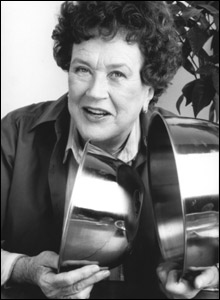Food and cultural historian Laura Shapiro likes to point out a certain week in 1963 when Julia Child first appeared on WGBH and Betty Friedan published The Feminine Mystique. The dates couldn’t have been much further apart in 1966 when Joyce Chen started her cooking show on WGBH, and a Boston University theater student published the first issues of what became the Boston Phoenix. In 1966, Boston wasn’t known as a particularly good restaurant town, outside of a few expensive places like Locke-Ober, Café Budapest, and the Ritz-Carlton dining room. The last two are gone, and Locke-Ober hangs on only because, after it excluded women from its main dining room for more than a century, it was rescued by Boston’s most famous female chef, Lydia Shire. In 1966, moreover, home cooking began and usually ended with Fannie Farmer, although some new ideas from Child and Chen were coming in via public television.
|

WONDER WOMAN: Julia Child appeared on WGBH in 1963. The rest is history.
|
But under the radar flew a whole different kind of restaurant and home cooking, appealing to a new generation of students and young professionals. The restaurants were inexpensive, ethnic, and bohemian. Such rooms, often mere storefronts with a dozen tables or fewer, were discussed in the pages of the Phoenix and its predecessors, and first joined our community of advertisers. Alt-weekly readers and writers might splurge at Maison Robert, the city’s finest French restaurant and a Julia Child favorite. But we frequented cheap Italian restaurants in the North End and such outposts of red-sauce value as Simeone’s in Cambridge. In an adventurous spirit, we might join the cult of computer hackers gathered over Peking ravioli at Joyce Chen’s Small Eating Place. A few people even ventured to Medford’s Peking on the Mystic for more of this new, spicy, and more-authentic Chinese food. Other gathering places included the handful of Greek and Lebanese restaurants downtown, in the South End, and Cambridge, like the old Athens Olympia and the original Red Fez. After midnight, you could get breakfast all night at a colorful spot in the central meat market called Mondo’s. (Mondo’s clientele of night-owl students, taxi drivers, artists, and prostitutes has never been reassembled, but its collection of amateur nude oil paintings was a precursor to the Museum of Bad Art.) Bars and luncheonettes with cheap comfort food were popular, such as the old Brookline Lunch in Central Square, which became a lefty political hangout, and the pre-punk Model Café in Allston. The English Tea Room at 29 Newbury Street had a certain flare, as did a hippy/Mexican restaurant in Harvard Square called El Diablo, and — upstairs from a Cambridge fish market — a barebones spot with paper plates and blackboard specials called Legal Sea Foods.
For a treat, Boston Phoenix readers sought out competing homemade-ice-cream parlors in Somerville. Boston has been an ice-cream region since the early-19th century, but the last 40 years have taken ice-cream mania to new levels. (This is one way Phoenix readers have always had fun with food: tasting something at the absolute top level of a basically inexpensive category. We may not wear $5000 watches, but we indulge in a high-end ice-cream cone after a modest meal, a super-premium bottle of beer with our burger, a superb silk scarf to accessorize our thrift-shop clothes.)
Home cooking was also seeing changes. For every dinner party featuring earnest reproductions of Child’s and Chen’s recipes, there were people going back to Asian basics with the Japanese-based macrobiotic diet, buying fresh figs and basil in North End markets, and reinventing the American food of their grandparents with added and unsuitable doses of whole-wheat flour, honey, and soy sauce.
The first food column in the Phoenix was a series of alternative-cooking stories about, well, alternative cooking. But the paper had already developed relationships with the small restaurants through its discount “BADAmericlub,” and also took on the sponsorship of a series of three Cheap Eats restaurant guidebooks. They included some of the better expensive restaurants but concentrated on cheap ethnic and family restaurants.
The second edition, in 1974, included a new restaurant on the Cambridge-Somerville line called Peasant Stock. Peasant Stock was based on French country cooking, filtered through Julia Child, but it was run on a cooperative principle in which different chefs cooked on different nights. The results were inconsistent but good enough to keep everyone interested. One person who cooked at Peasant Stock was R.D. Rosen, who in the mid 1970s became the first Phoenix weekly restaurant critic. One of the owners was Louisa Kasdon, who now covers restaurants for Phoenix sister publication Stuff@night magazine.
By the mid ’70s, Joyce Chen’s encouragement of Mandarin-Sichuan chefs from Taiwan and Hong Kong (and the 1965 immigration-reform bill that ended discrimination against Asian immigrants) had led to almost two dozen exciting Sichuan-style restaurants in Greater Boston. (You can still get the idea today at Chung Shin Yuan in Newton, or at Mary Chung’s or Changsho in Cambridge.)